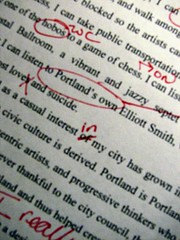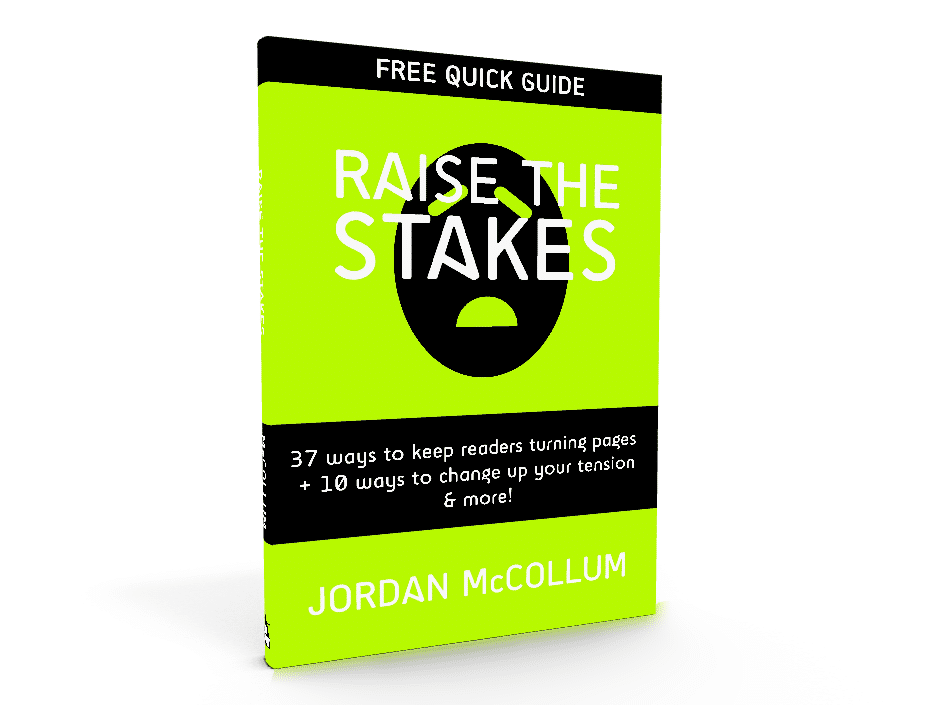By Annette Lyon
If you enjoy this guest post, be sure to check out the series on writing dialogue!
Back in my days writing for a small newspaper, I often did book reviews. One day a publicist handed me a self-published book. It was a semi-autobiographical novel, and the concept seemed interesting. I looked forward to reading it.
 That is, until I got about four lines into page one. The book was a mess from start to finish. Even though I read the thing about a dozen years ago, I could still rant for days on the all the problems in the book (let’s just say this guy didn’t have the first clue about how to put together a coherent story, let alone a coherent sentence).
That is, until I got about four lines into page one. The book was a mess from start to finish. Even though I read the thing about a dozen years ago, I could still rant for days on the all the problems in the book (let’s just say this guy didn’t have the first clue about how to put together a coherent story, let alone a coherent sentence).
One particular peeve still stands out: the use of funky verbs instead of normal dialogue tags. In the first chapter, I noticed that no one ever said anything.
They began, interrupted, rebutted, chided, complained, warned, replied, whispered, teased, mumbled, proclaimed, ordered, confessed, pressed, affirmed, announced, proposed, confirmed, suggested, and (some of my favorites) guiltily petitioned, sarcastically rebutted, and proficiently advised.
I could tell the guy had a thesaurus and was trying hard not to use “said.” The result felt ridiculous. Finding his goofy dialogue tags became a game for me. I wrote down every one from the first chapter.
The list had over 90 tags. Not ONE used “said.”
By this point, my eye was seriously twitching with annoyance. I have a sneaking suspicion that I also laughed out loud . . . several times.
Here are three basic rules for dialogue tags that this author could have really used.
Rule #1: “Said.” Use it 90% of the time.
It’s our happy verb.
While you don’t normally want to be repeating the same words over and over in your work, “said” (contrary to what this guy thought) tends to be invisible. It disappears while it helps the reader keep track of who is saying what.
Remember that you don’t need “said” (or any tag) after every single line of dialogue. If the speaker is clear, you can leave off the tag altogether. But when it doubt, use “said.”
Rule #2: If you decide to use a verb other than “said,” be sure it’s a speakable verb.
 For example, don’t do this: “These flowers are for you,” he smiled.
For example, don’t do this: “These flowers are for you,” he smiled.
Um, no. Smiles are silent. You can’t smile words. You can smile while speaking words. You can smile and then speak them. But smiles themselves can’t speak.
Other non-speakable verbs often used as tags include sniffed, nodded, shrugged, and a hundred others.
That horrific book I slogged through used “her eyes begged” as a speech tag.
(Wow. Those are some pretty special—and loud—eyes.)
Rule #3: Use actions (sure, even “her eyes begged”) when referring to dialogue.
Just don’t use it as a speech tag. Instead, put those action verbs next to the dialogue in their own sentences, complete with end-of-sentence punctuation.
Otherwise, the action is the thing speaking, and we all know that’s impossible.
So this would be just fine:
He smiled. “These flowers are for you.”
Or, use “said” and then add the verb next to it. So this works too:
“These flowers are for you,” he said, smiling.
Examples with actions only:
Steve walked into April’s apartment and handed her a bouquet of roses. “These are for you.”
OR
He got down on one knee. “Will you marry me?” His eyes begged to know the answer.
See? No speech tags at all. Even better, no funky verbs that can’t be realistically spoken. All we have are actions separated by clear punctuation like a period or question mark, plus dialogue we instinctively know belongs to the right speaker.
If you use these three rules, the verbs in your tags will look far more professional—and they won’t give a reviewer eye twitches and a serious case of the giggles.
So please, no more (hmm . . . let’s consult my list of 90-some tags from chapter one): stammering, grumbling, ordering, proposing, affirmed, or quizzing, what say?
Annette Lyon has been writing ever since second grade, when she piled pillows on a chair to reach her mother’s typewriter. A cum laude graduate from BYU with a degree in English, she has had success with newspaper, magazine, and business writing, but her first love is fiction. She was awarded Utah’s Best of State medal for fiction in 2007. Tower of Strength, her sixth and most recent novel, is her fourth historical centered around old Utah temples.
If you enjoy this guest post, be sure to check out the series on writing dialogue!
Photo credits—Reader by Chris Johnson; smile by jdurham123.
 And that’s just one type of rhetorical repetition. I applaud repetition for a good purpose—cadence, humor, contrast. Lather, rinse, repeat!
And that’s just one type of rhetorical repetition. I applaud repetition for a good purpose—cadence, humor, contrast. Lather, rinse, repeat!



 And speaking of characters, and keeping with our theme this month, I wanted to focus on two specific words that many people use interchangeably: sympathy and empathy. I realized that, while I sense a difference, I can’t really say for certain what it is. So I turned to some dictionaries.
And speaking of characters, and keeping with our theme this month, I wanted to focus on two specific words that many people use interchangeably: sympathy and empathy. I realized that, while I sense a difference, I can’t really say for certain what it is. So I turned to some dictionaries.  ). Those examples aren’t the most transparent, but it means “with,” or “together.”
). Those examples aren’t the most transparent, but it means “with,” or “together.”
 Thee problem is this: there’s only a handful of words in the English language to express those actions: smile, beam, grin, smirk, simper. Nodding is even worse: nod. Other versions of this one tend to draw attention to the words instead of showing the characters’ actions: bobbed his head (“up and down,” if you want to make it even more annoying).
Thee problem is this: there’s only a handful of words in the English language to express those actions: smile, beam, grin, smirk, simper. Nodding is even worse: nod. Other versions of this one tend to draw attention to the words instead of showing the characters’ actions: bobbed his head (“up and down,” if you want to make it even more annoying).  And do they need the forbidden modifier? I think so. Can you infer the meaning of his grin with just “He smiled at her”? (I have two images in mind here: “He smiled at her. Mmm. Lunch.” and “He smiled at her. Oh, a friend.”) A thumb chewer may be a small child seeking comfort, an adult pondering a problem or a guy with a nervous habit.
And do they need the forbidden modifier? I think so. Can you infer the meaning of his grin with just “He smiled at her”? (I have two images in mind here: “He smiled at her. Mmm. Lunch.” and “He smiled at her. Oh, a friend.”) A thumb chewer may be a small child seeking comfort, an adult pondering a problem or a guy with a nervous habit. Contrary to popular thought, not all action verbs are strong verbs. In the sentence “Ali walked down the road,” “walked” is an action verb. It is also a generic verb. It tells us that Ali is using her feet to advance across a surface and nothing else.
Contrary to popular thought, not all action verbs are strong verbs. In the sentence “Ali walked down the road,” “walked” is an action verb. It is also a generic verb. It tells us that Ali is using her feet to advance across a surface and nothing else.  Consider this sentence: “Sari’s words caused Anthony great confusion.” The sentence is grammatically correct. Moreover, its meaning is clear. But how much more vivid and exact is the revised sentence “Sari’s words confused Anthony”? Or even better, “Sari’s words baffled Anthony.”
Consider this sentence: “Sari’s words caused Anthony great confusion.” The sentence is grammatically correct. Moreover, its meaning is clear. But how much more vivid and exact is the revised sentence “Sari’s words confused Anthony”? Or even better, “Sari’s words baffled Anthony.”  That is, until I got about four lines into page one. The book was a mess from start to finish. Even though I read the thing about a dozen years ago, I could still rant for days on the all the problems in the book (let’s just say this guy didn’t have the first clue about how to put together a coherent story, let alone a coherent sentence).
That is, until I got about four lines into page one. The book was a mess from start to finish. Even though I read the thing about a dozen years ago, I could still rant for days on the all the problems in the book (let’s just say this guy didn’t have the first clue about how to put together a coherent story, let alone a coherent sentence). For example, don’t do this: “These flowers are for you,” he smiled.
For example, don’t do this: “These flowers are for you,” he smiled. 